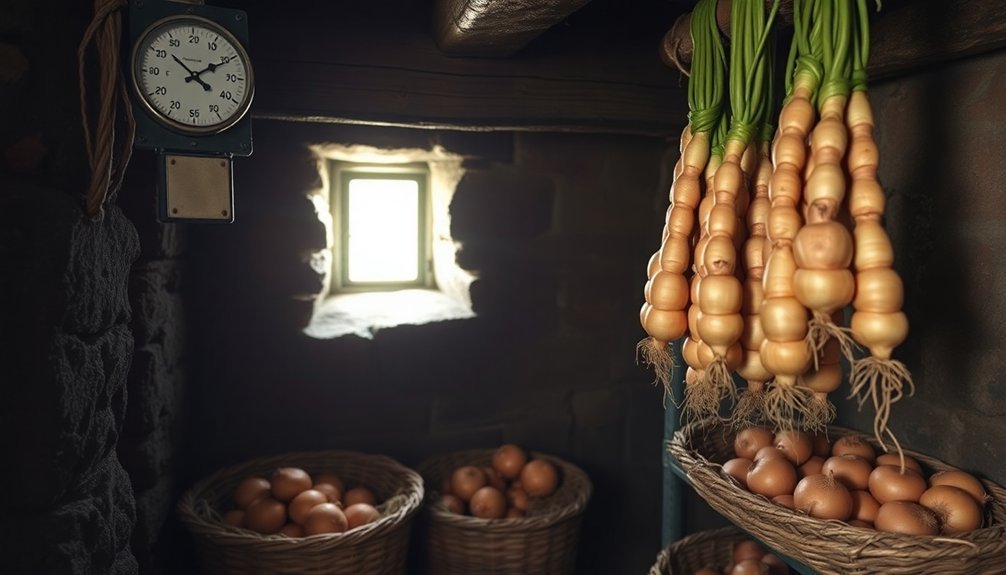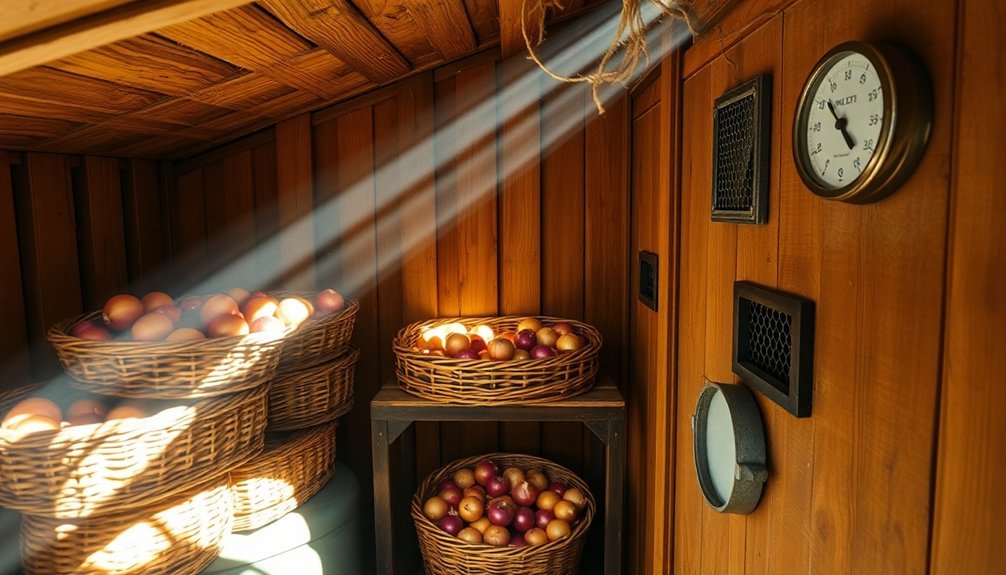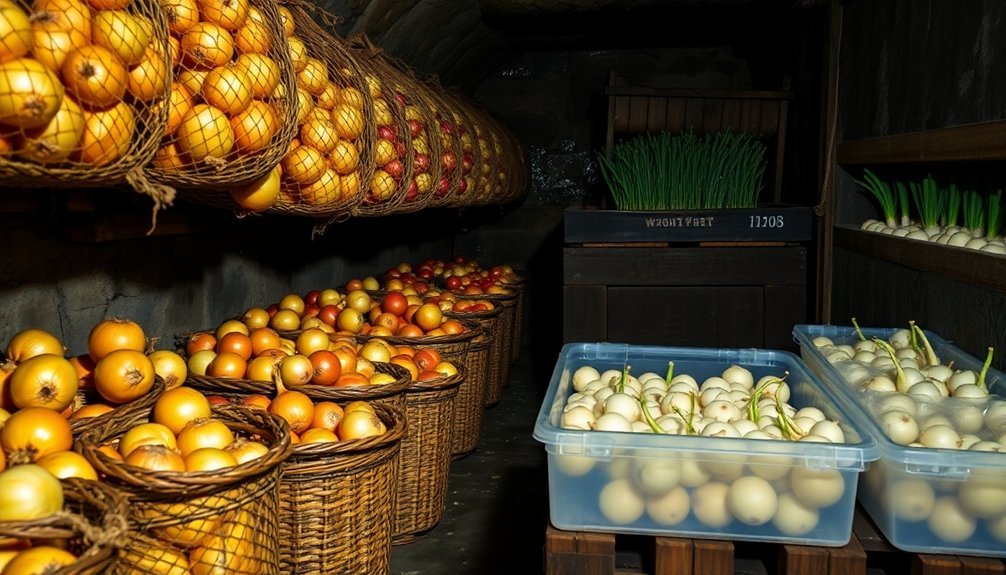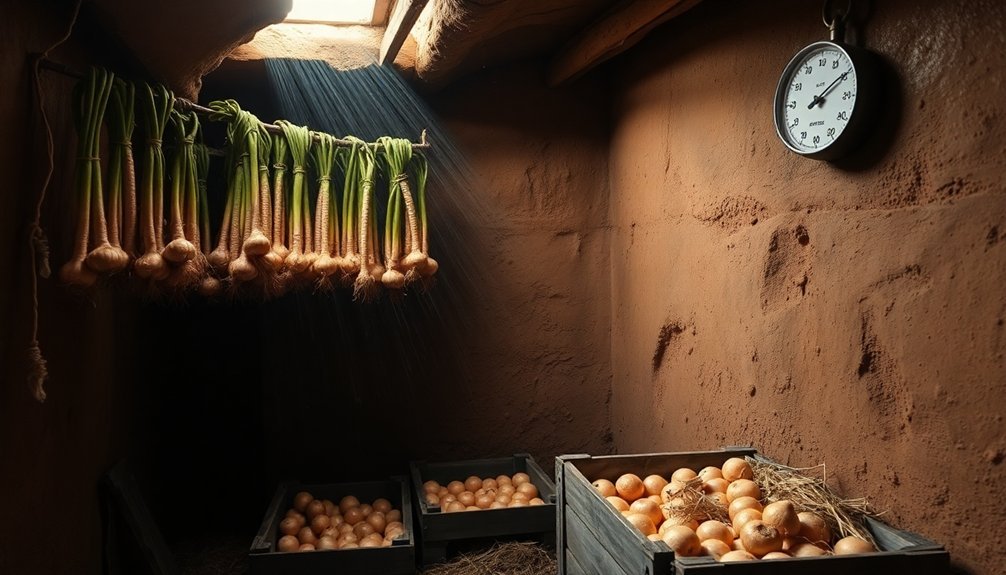Root cellars extend your onions' storage life by providing the perfect environment with consistent temperatures between 32-40°F and humidity levels of 60-70%. You'll find these underground spaces naturally maintain ideal conditions through earth insulation, while proper ventilation prevents moisture buildup and spoilage. Dark conditions stop premature sprouting, and the cool temperatures slow down the aging process. When you combine these factors with good air circulation from a two-vent system, your onions can stay fresh for up to 8 months. Understanding the specific techniques for managing these conditions will help you maximize your storage success.
Perfect Root Cellar Temperature Range

Nearly every successful root cellar maintains a precise temperature range between 32°F and 40°F (0°C to 4°C) to maximize vegetable storage life.
You'll find that this temperature sweet spot is particularly vital for onions, which can last considerably longer when stored under these conditions.
To achieve this ideal range, you'll benefit from the earth's natural temperature stability. The deep ground maintains a consistent temperature that helps shield your stored vegetables from the fluctuating temperatures above ground. Using a dirt floor will help maintain optimal temperature levels.
You'll need to avoid temperatures below 32°F, as freezing conditions will damage your produce and make it unusable.
When you're setting up your root cellar, you'll want to install proper insulation and ventilation systems to maintain these temperatures.
You can regulate the cellar's climate by using cool night air and the ground's natural cooling properties.
It's important to monitor the temperature regularly using strategically placed thermometers throughout your storage space.
If you need to make minor adjustments, a simple 100-watt light bulb can provide just enough heat to maintain the ideal range when temperatures dip too low.
Controlling Humidity for Optimal Storage
You'll need to maintain a careful balance of humidity in your root cellar, keeping levels between 60-70% to prevent both mold growth and excessive drying of your onions.
To manage condensation buildup, store your onions in mesh bags or baskets that promote airflow and prevent moisture from collecting on the bulbs.
Setting up proper ventilation controls, such as adjustable vents or small fans, will help you regulate humidity levels and keep your onions in ideal storage conditions. Unlike most vegetables that thrive in high humidity, cucurbits and onions prefer drier conditions to maintain their quality during storage.
Moisture Balance Best Practices
Maintaining proper humidity levels stands as one of the most critical factors in successful onion storage. You'll want to keep humidity between 65-75% while maintaining temperatures of 32-40°F (0-4°C). This temperature range aligns with traditional root cellaring methods that have preserved produce for centuries. Using a hygrometer near your storage boxes will help you monitor these conditions and make necessary adjustments to protect your harvest.
To achieve ideal moisture balance, you'll need proper ventilation and appropriate storage containers. Set up fans or vents to keep air moving and prevent stagnant conditions that can lead to mold growth. Choose containers that promote airflow, such as mesh bags or wooden crates, and avoid plastic materials that trap moisture.
- Place onions in single layers within net bags, allowing air to circulate freely around each bulb.
- Add natural moisture-absorbing materials like clean hay or sawdust to help regulate humidity.
- Position storage containers away from walls to promote better airflow.
If you notice humidity climbing above 75%, increase ventilation immediately to prevent rot. Conversely, if levels drop below 65%, your onions might dry out too quickly.
Regular monitoring with your hygrometer will help you maintain this delicate balance, ensuring your onions stay fresh longer in your root cellar.
Managing Condensation Buildup
Proper condensation control in your root cellar directly impacts the longevity of stored onions. You'll need to maintain humidity levels between 60-70% to prevent both mold growth and excessive drying. Using hygrometers helps you monitor these conditions accurately and adjust your ventilation accordingly.
To prevent condensation buildup, make sure the incoming air's dewpoint temperature doesn't exceed your stored onions' temperature. You'll want to avoid ventilating during sunny winter days when warm air can create unwanted moisture on cooler onions.
Install a two-opening ventilation system, with inlet vents near the floor and outlet vents near the ceiling, to create effective air circulation.
Protect your root cellar from external moisture by waterproofing walls and floors. You can install a French drain along the exterior base and use plastic sheeting over gravel floors to prevent ground moisture from seeping in.
Add extractor fans to remove heavy, moist air, and position additional fans strategically to maintain even temperatures throughout the space.
Don't forget to regularly check and clear your vents to maintain proper airflow. By implementing these measures, you'll create an environment that greatly extends your onions' storage life.
Ventilation Controls Humidity Levels
Effective ventilation serves as the cornerstone of humidity control in root cellars, directly influencing how well your onions survive long-term storage.
You'll want to maintain humidity levels between 65-75% to prevent both mold growth and excessive drying. By positioning your air intake low and outlet high, you're creating a natural flow that pushes warm, moist air out while drawing cooler air in.
To maximize airflow around your stored onions, you'll need to:
- Store onions in mesh bags or slatted crates, keeping them elevated from the floor
- Space storage containers apart to allow air circulation between them
- Layer onions with newspaper or straw to prevent direct contact while maintaining airflow
Your ventilation system's effectiveness depends on your cellar's size and construction. If you've got a large or tightly sealed space, you'll need both intake and outlet vents.
For smaller areas with natural cracks, a single outlet vent might suffice. You can monitor humidity levels using a hygrometer, adjusting your ventilation accordingly.
Remember to periodically rotate storage containers to guarantee all your onions receive adequate airflow, preventing moisture buildup that could lead to spoilage.
Essential Air Flow Methods

Air circulation serves as the cornerstone of a successful root cellar storage system. To achieve ideal airflow for your onions, you'll need to implement a two-vent design that manages both incoming and outgoing air.
Install your inlet vent near the floor to allow cool air to enter and rise naturally through your stored onions, while positioning the outlet vent high up, preferably near the ceiling, to let warm, humid air escape.
You'll want to maintain specific airflow rates during different storage phases. During the critical drying period, make sure you're moving about 2 cubic feet of air per minute for each cubic foot of onions.
Once you've reached the holding period, you can reduce this to 1 cubic foot per minute. For the most effective ventilation, consider installing a vertical vent stack that extends above ground level – this creates stronger natural airflow than horizontal venting.
When you're operating fans, run them only when necessary to maintain proper temperature or remove excess humidity. Remember to prevent condensation by making sure your air's dewpoint temperature stays at or below your onion temperature, and keep circulating air throughout your storage space for even temperature distribution.
Proper Curing Before Storage
You'll need to allow 14-20 days for your onions to dry and cure properly before storing them in your root cellar.
Whether you choose natural field curing for at least 5 days or artificial hot-air curing for 16-24 hours at 115°F, the process is essential for extending storage life.
You can tell your onions are properly cured when the necks have thoroughly dried and shrunk, indicating they're ready for long-term storage.
Drying Time And Methods
Proper curing stands out as one of the most vital steps in preparing onions for long-term storage. You'll need to cure your onions for 2-3 weeks in a warm, dry area with temperatures between 75°F to 85°F. During this time, make certain you're keeping them out of direct sunlight to prevent sunburn damage.
You've got several effective methods to choose from when curing your onions:
- Lay them in a single layer on screens or shelves, making sure they don't overlap
- Hang them upside-down, which works particularly well if you plan to braid them later
- Use the natural field-curing method by windrowing and topping
Your onions are fully cured when their outer skins become papery and their necks are completely shriveled and dry. In dry climates, you might achieve this in just two weeks, while humid conditions could extend the process to four weeks.
Neck Shrinkage Signs
Several key signs indicate when your onions have achieved proper neck shrinkage during the curing process. You'll notice the necks become completely dry and tight, while the outer bulb scales develop a papery, rustling texture. When you roll the neck tissue between your fingers, it shouldn't slide – this confirms it's properly dried and secure.
| Indicator | What to Look For | Why It's Important |
|---|---|---|
| Neck Condition | Dry, tight, no sliding tissue | Prevents pathogen entry |
| Outer Scales | Papery, rustling texture | Forms protective wrapper |
| Leaf Status | Shriveled, dried out | Shows completed curing |
| Top Seal | Necks closed at bulb top | Blocks moisture entry |
Proper neck shrinkage is essential for long-term storage success. It creates a natural barrier against moisture and pathogens, particularly Botrytis neck rot. When you're checking for neck shrinkage, remember to handle the onions gently to avoid creating bruises that could become entry points for disease. Once you've confirmed proper shrinkage, trim the tops to 2-3 inches and the roots to 1 inch before moving your onions to cool, dark storage at 32°F with 65-70% humidity.
Choosing Storage Containers

Selecting the right storage containers for your onions can greatly impact their longevity in your root cellar. You'll find that both plastic and wooden containers can effectively store your onions, as studies show there's no significant difference in E. coli contamination between sterilized plastic crates and wooden boxes.
The key is ensuring proper ventilation, regardless of the material you choose.
When selecting containers, focus on these essential features:
- Built-in ventilation holes or mesh design to maintain consistent airflow
- Opaque materials that protect onions from light exposure
- Stackable design for efficient space utilization in your root cellar
For ideal storage, you can use traditional wooden boxes, ventilated plastic crates, or specialized containers like the Onion & Garlic Smart™ Container. These specialized solutions can hold up to 5 pounds of produce and feature designs that promote optimal air circulation.
If you're looking for a cost-effective option, wooden boxes work just as well as their modern counterparts. Remember to keep your containers clean and dry, and position them off the ground to prevent moisture buildup.
Net bags and mesh baskets are also excellent alternatives that provide superior ventilation.
Dark Environment Benefits
Through the use of dark storage conditions, you'll maximize your onions' shelf life and maintain their quality over extended periods. Darkness prevents sprouting, which is vital since light exposure triggers onions to break dormancy and start growing. When onions sprout, they use their stored energy, resulting in softer, less flavorful bulbs.
You'll find that dark environments also help control moisture absorption. When you store onions in darkness, they're less likely to absorb excess moisture, which greatly reduces the risk of mold and rot. The stable humidity levels in dark storage areas help maintain the onions' characteristic dry, papery skin.
Dark storage spaces typically offer more consistent temperatures, ideally between 32-50°F (0-10°C). These stable conditions prevent temperature fluctuations that can speed up spoilage and sprouting. Additionally, darkness limits the growth of bacteria and fungi that cause decay.
You'll want to check your stored onions regularly and remove any spoiled ones promptly, as they can affect nearby bulbs. By maintaining proper dark storage conditions, you'll effectively extend your onions' shelf life while preserving their firmness and flavor.
Natural Climate Control Systems

While proper darkness helps protect your onions, the root cellar's natural climate control system works as your primary preservation tool. The earth's natural insulation maintains temperatures between 32-50°F (0-10°C) and humidity levels between 85-95%, creating a perfect environment for long-term storage.
You'll find that digging into a hillside or using the earth's surrounding mass provides consistent cooling without the need for external systems.
The root cellar's climate control relies on three key components working together: temperature, humidity, and ventilation. You'll need to keep temperatures between 33-40°F (0.5-4°C) to prevent sprouting, while maintaining humidity at 60-70% to avoid dehydration. Proper ventilation helps manage both factors and prevents ethylene gas buildup.
- Underground positioning provides natural temperature regulation, minimizing fluctuations that could damage your onions.
- Ventilation systems, whether passive or solar-powered, allow you to adjust airflow as needed.
- Simple humidity controls, like water trays or damp sand, help you maintain ideal moisture levels.
Monitor these conditions regularly with thermometers and hygrometers to verify your onions remain in peak condition throughout their storage period.
Frequently Asked Questions
Can Onions Be Stored With Other Vegetables in a Root Cellar?
You can store onions with other vegetables in your root cellar, but you'll need separate areas since onions require lower humidity (50%) than root vegetables (90-95%) and should be kept off the ground.
How Long Can Onions Typically Last When Stored Properly in Root Cellars?
When you store your onions properly in a root cellar with ideal temperature, humidity, and ventilation conditions, they'll last between 1-9 months. With excellent storage practices, you can extend this to 10 months.
What Signs Indicate That Stored Onions Are Starting to Go Bad?
You'll know your onions are spoiling if you spot mold, soft spots, or sprouting. Watch for slimy textures, unusual colors, strong unpleasant odors, and mushiness when pressed. Check regularly for these warning signs.
Should Onions Be Washed Before Storing Them in a Root Cellar?
You shouldn't wash onions before root cellar storage. Instead, gently brush off excess dirt, as washing adds unwanted moisture that can lead to rot and mold. Washing also damages the protective outer skin.
Can Frozen Onions Be Safely Moved to a Root Cellar for Storage?
No, you shouldn't move frozen onions to a root cellar. Once they're frozen, their cell structure's damaged, and they'll turn mushy when thawed. It's best to use frozen onions immediately after thawing.
In Summary
You'll find your onions last notably longer in root cellars because they provide the perfect combination of cool temperatures, controlled humidity, and proper airflow. By storing your onions in a dark environment at 32-40°F with 65-70% humidity, you're creating ideal conditions that slow down sprouting and decay. When you've properly cured them first and use the right storage containers, you'll enjoy fresh onions for months.





Leave a Reply